By Mark Frost, Chronicle Editor
Two must-see events got me to New York City on a weekend in November.
One, “Edward Hopper’s New York,” a major show focused on my favorite American artist, at the Whitney Museum of American Art. (See coverage at right.)
Two, comedian Shane Gillis performing at The Town Hall near Times Square as part of the New York Comedy Festival.
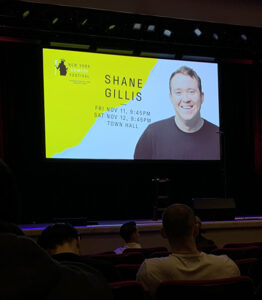
The clincher was that both my sons were on-board (for the comedy, not the art). Zander and his girlfriend trained it with me from Rensselaer. They stayed at Max’s apartment, while I opted for a hotel.
Max had already seen Shane Gillis live at a smaller venue in New York and called him the current best comedian. And it was Zander who turned me on to him in the first place, playing audio bits as we drove delivering Chronicles. Very funny.
Gillis was briefly famous (notorious?) because Saturday Night Live tapped him as a cast member, then before he ever performed, cancelled him because an old politically incorrect routine was surfaced.
Gillis rebounded. He produced his own comedy special, posted it free on YouTube, where it became a sensation that launched him. Like Tim Dillon and Joe Rogan, he’s making it outside the mainstream, so the networks and corporate media pretty much ignore him.
Gillis tests taboos — his comedy isn’t for the easily offended — but he comes across as an amiable, very funny, regular guy whose original take on people, politics, American presumptions, masculinity, himself and the world is compelling.
A Gillis family member has Down Syndrome which enables Gillis to be perhaps the only comedian in the world making Down Syndrome jokes, hilariously.
Zander’s girlfriend and I didn’t care for the two opening comedians — both Gillis sidekicks — but the instant Shane took the stage, placed his two Bud Light bottled beers on the stool next to him, and spoke into the microphone, he had our whole audience in the palm of his hand.
Thorough confidence, surpassing skill.
I’d readily go see him again “live,” even if he tells a lot of the same jokes.
What’s almost as good as catching an excellent comedian at work in the Big Apple? Finding a good, cheap restaurant at which to eat.
Before Shane Gillis’s show, Max led us to Nan Xiang Xiao Long Bao at 20 West 33rd Street. Max knew about it because he discovered its flagship in the Chinese neighborhood in Queens that Max says is just like being in China itself.
“Nan Xiang is the first choice for local Chinese immigrants who are craving for authentic Northern Chinese food, Jiangsu & Zhejiang cuisine,” says the website.
Four of us snarfed down Beef Scallion Pancake, Sweet & Sour Black Wood Ear Mushroom, Shanghai Fried Udon, Four Happiness Sponge Tofu along with a total of two Sapporo beers. Delicious!
Total price with tax $100.71. Can’t beat that value in the Big Apple!
‘Edward Hopper’s New York’ a major event at the Whitney
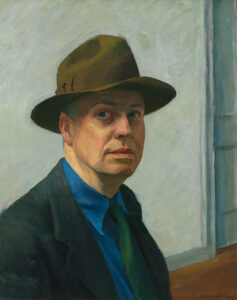
1925–30. Oil on canvas, 25 3/8 × 20 3/8 in. (64.5 × 51.8 cm). Whitney Museum of American Art, New York; Josephine N. Hopper Bequest 70.1165. © 2022 Heirs of Josephine N. Hopper/Licensed by Artists Rights Society (ARS), New York
Chronicle editor Mark Frost writes, Edward Hopper (1908-1967) is my favorite American artist.
“Because he’s depressing,” quips my wife Sandra.
I prefer the word haunting.
Hopper depicts people not quite in tune with each other. Are they alienated? Are they lonely? He shows buildings that are stark mysteries. He fuzzes lettering, entices you to notice shades and curtains, wondering about tiny details, differences and what’s going on inside.
The Whitney Museum of American Art was the earliest purchaser of Hopper’s art, and has now mounted a major show, “Edward Hopper’s New York,” on view now through March 5, 2023.
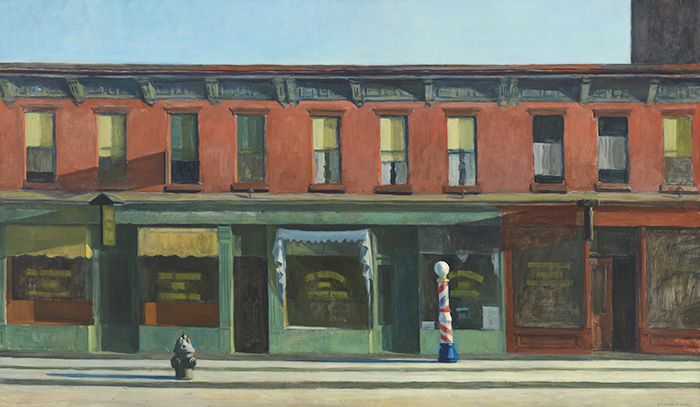
Edward Hopper, Early Sunday Morning, 1930. Oil on canvas, 35 3/16 × 60 1/4 in. (89.4 × 153 cm). Whitney Museum of American Art, New York; purchase with funds from Gertrude Vanderbilt Whitney 31.426. © 2019 Heirs of Josephine N. Hopper / Licensed by VAGA at Artists Rights Society (ARS), New York
It’s of great interest nationally and internationally. Even in early November, crowds were enormous, and difficult to spectate around. Admission is timed, though you can stay long as you please.
The show makes numerous points that will stay with me.
One, as Hopper painted, skyscrapers were rising and Manhattan went vertical, but his work is defiantly horizontal.
In fact, Hopper actively fought the modernization. He and his artist wife Josephine Nivison spent their decades living in a vintage walk-up apartment building in Greenwich Village.
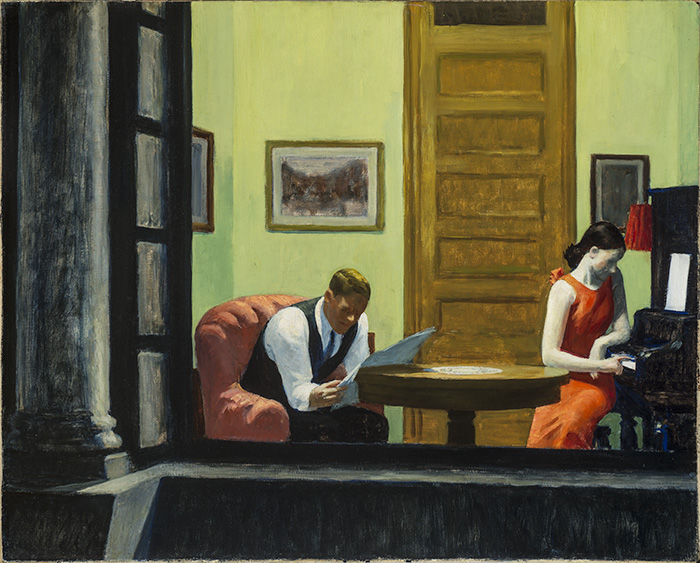
Edward Hopper, Room in New York, 1932. Oil on canvas, 29 × 36 in. (73.7 × 91.4 cm). Sheldon Museum of Art, University of Nebraska—Lincoln; Anna R. and Frank M. Hall Charitable Trust. © 2022 Heirs of Josephine N. Hopper/Licensed by Artists Rights Society (ARS), New York
They fiercely resisted New York University’s razing the old neighborhood to erect modern college buildings.
I really enjoyed reading displayed letters from and to Hopper as their preservation battles were engaged.
Hopper, a native of Nyack north of the City, was also all about the elevated trains (the El), another essential aspect of Manhattan at the time.
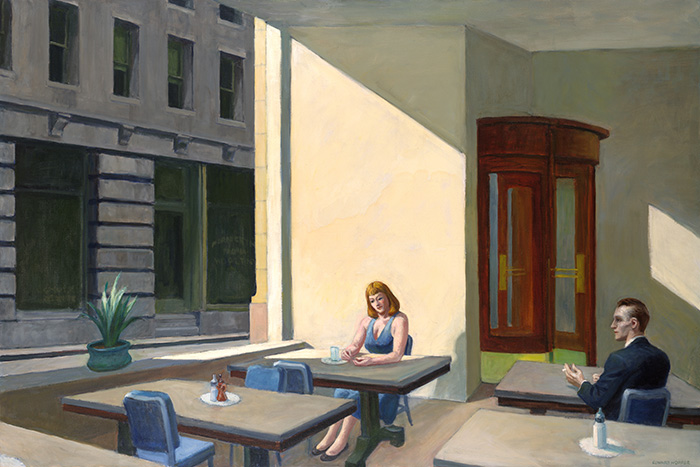
Edward Hopper, Sunlight in a Cafeteria, 1958. Oil on canvas, 40 3/16 × 60 1/8 in. (102.1 × 152.7 cm). Yale University Art Gallery, New Haven; bequest of Stephen Carlton Clark, B.A. 1903. © 2022 Heirs of Josephine N. Hopper/Licensed by Artists Rights Society (ARS), New York
The show suggests that Hopper’s views into second-story windows as he rode the train led to his many paintings that glimpse moments in apartments.
(A former elevated train line that was due to be razed has instead been transformed into the High Line walking route whose southern end is the Whitney.)
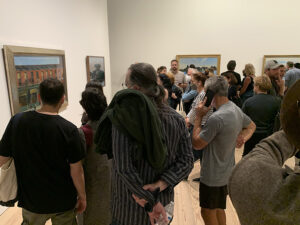
My favorite painting in the show was Tables for Ladies, 1930. Unfortunately, I can’t show it to you. It’s not authorized to reproduce in the newspaper. You can find the image on the Internet. It’s a sly work by Hopper. It’s a very upscale restaurant, but the focus is not on well-heeled customers, instead on two working women — one arranging fruit in the foreground, the other the hostess at her podium. It was more overt in making its point than most Hopper works. It grabbed me.
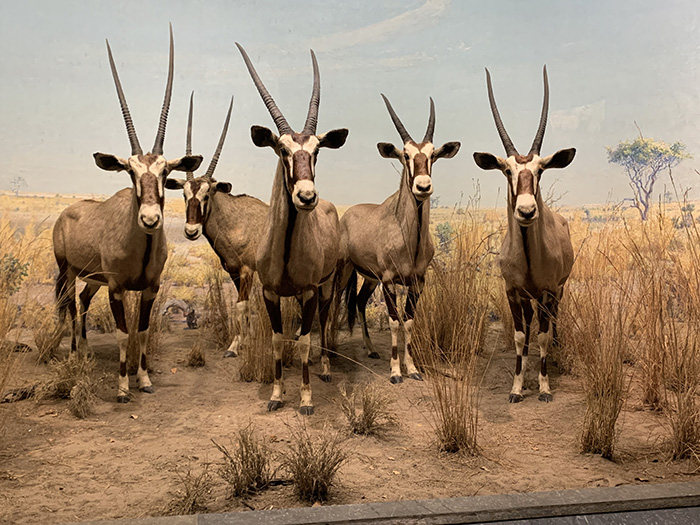
Copyright © 2022 Lone Oak Publishing Co., Inc. All Rights Reserved
 Glens Falls Chronicle Serving the Glens Falls/Lake George region; Warren, Washington and northern Saratoga counties since 1980
Glens Falls Chronicle Serving the Glens Falls/Lake George region; Warren, Washington and northern Saratoga counties since 1980

